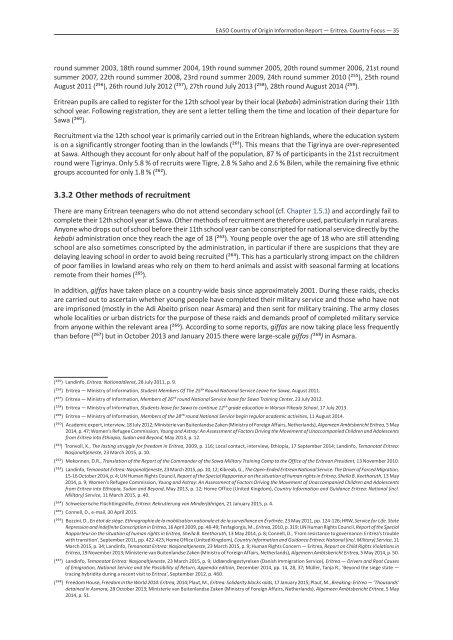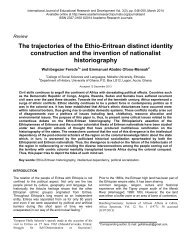Create successful ePaper yourself
Turn your PDF publications into a flip-book with our unique Google optimized e-Paper software.
EASO Country of Origin Information <strong>Report</strong> — <strong>Eritrea</strong>. Country Focus — 35<br />
round summer 2003, 18th round summer 2004, 19th round summer 2005, 20th round summer 2006, 21st round<br />
summer 2007, 22th round summer 2008, 23rd round summer 2009, 24th round summer 2010 (255), 25th round<br />
August 2011 (256), 26th round July 2012 (257), 27th round July 2013 (258), 28th round August 2014 (259).<br />
<strong>Eritrea</strong>n pupils are called to register for the 12th school year by their local (kebabi) administration during their 11th<br />
school year. Following registration, they are sent a letter telling them the time and location of their departure for<br />
Sawa (260).<br />
Recruitment via the 12th school year is primarily carried out in the <strong>Eritrea</strong>n highlands, where the education system<br />
is on a significantly stronger footing than in the lowlands (261). This means that the Tigrinya are over-represented<br />
at Sawa. Although they account for only about half of the population, 87 % of participants in the 21st recruitment<br />
round were Tigrinya. Only 5.8 % of recruits were Tigre, 2.8 % Saho and 2.6 % Bilen, while the remaining five ethnic<br />
groups accounted for only 1.8 % (262).<br />
3.3.2 Other methods of recruitment<br />
There are many <strong>Eritrea</strong>n teenagers who do not attend secondary school (cf. Chapter 1.5.1) and accordingly fail to<br />
complete their 12th school year at Sawa. Other methods of recruitment are therefore used, particularly in rural areas.<br />
Anyone who drops out of school before their 11th school year can be conscripted for national service directly by the<br />
kebabi administration once they reach the age of 18 (263). Young people over the age of 18 who are still attending<br />
school are also sometimes conscripted by the administration, in particular if there are suspicions that they are<br />
delaying leaving school in order to avoid being recruited (264). This has a particularly strong impact on the children<br />
of poor families in lowland areas who rely on them to herd animals and assist with seasonal farming at locations<br />
remote from their homes (265).<br />
In addition, giffas have taken place on a country-wide basis since approximately 2001. During these raids, checks<br />
are carried out to ascertain whether young people have completed their military service and those who have not<br />
are imprisoned (mostly in the Adi Abeito prison near Asmara) and then sent for military training. The army closes<br />
whole localities or urban districts for the purpose of these raids and demands proof of completed military service<br />
from anyone within the relevant area (266). According to some reports, giffas are now taking place less frequently<br />
than before (267) but in October 2013 and January 2015 there were large-scale giffas (268) in Asmara.<br />
(255) Landinfo, <strong>Eritrea</strong>: Nationaldienst, 28 July 2011, p. 9.<br />
(256) <strong>Eritrea</strong> — Ministry of Information, Student Members Of The 25th Round National Service Leave For Sawa, August 2011.<br />
(257) <strong>Eritrea</strong> — Ministry of Information, Members of 26th round National Service leave for Sawa Training Center, 23 July 2012.<br />
(258) <strong>Eritrea</strong> — Ministry of Information, Students leave for Sawa to continue 12th grade education in Warsai-Yikealo School, 17 July 2013.<br />
(259) <strong>Eritrea</strong> — Ministry of Information, Members of the 28th round National Service begin regular academic activities, 11 August 2014.<br />
(260) Academic expert, interview, 18 July 2012; Ministerie van Buitenlandse Zaken (Ministry of Foreign Affairs, Netherlands), Algemeen Ambtsbericht <strong>Eritrea</strong>, 5 May<br />
2014, p. 47; Women’s Refugee Commission, Young and Astray: An Assessment of Factors Driving the Movement of Unaccompanied Children and Adolescents<br />
from <strong>Eritrea</strong> into Ethiopia, Sudan and Beyond, May 2013, p. 12.<br />
(261) Tronvoll, K., The lasting struggle for freedom in <strong>Eritrea</strong>, 2009, p. 116; Local contact, interview, Ethiopia, 17 September 2014; Landinfo, Temanotat <strong>Eritrea</strong>:<br />
Nasjonaltjeneste, 23 March 2015, p. 10.<br />
(262) Mekonnen, D.R., Translation of the <strong>Report</strong> of the Commander of the Sawa Military Training Camp to the Office of the <strong>Eritrea</strong>n President, 13 November 2010.<br />
(263) Landinfo, Temanotat <strong>Eritrea</strong>: Nasjonaltjeneste, 23 March 2015, pp. 10, 12; Kibreab, G., The Open-Ended <strong>Eritrea</strong>n National Service: The Driver of Forced Migration,<br />
15-16 October 2014, p. 4; UN Human Rights Council, <strong>Report</strong> of the Special Rapporteur on the situation of human rights in <strong>Eritrea</strong>, Sheila B. Keetharuth, 13 May<br />
2014, p. 9; Women’s Refugee Commission, Young and Astray: An Assessment of Factors Driving the Movement of Unaccompanied Children and Adolescents<br />
from <strong>Eritrea</strong> into Ethiopia, Sudan and Beyond, May 2013, p. 12; Home Office (United Kingdom), Country Information and Guidance <strong>Eritrea</strong>: National (incl.<br />
Military) Service, 11 March 2015, p. 40.<br />
(264) Schweizerische Flüchtlingshilfe, <strong>Eritrea</strong>: Rekrutierung von Minderjährigen, 21 January 2015, p. 4.<br />
(265) Connell, D., e-mail, 30 April 2015.<br />
(266) Bozzini, D., En état de siège. Ethnographie de la mobilisation nationale et de la surveillance en Érythrée, 23 May 2011, pp. 124-126; HRW, Service for Life. State<br />
Repression and Indefinite Conscription in <strong>Eritrea</strong>, 16 April 2009, pp. 48-49; Tesfagiorgis, M., <strong>Eritrea</strong>, 2010, p. 319; UN Human Rights Council, <strong>Report</strong> of the Special<br />
Rapporteur on the situation of human rights in <strong>Eritrea</strong>, Sheila B. Keetharuth, 13 May 2014, p. 8; Connell, D., ‘From resistance to governance: <strong>Eritrea</strong>’s trouble<br />
with transition’, September 2011, pp. 422-423; Home Office (United Kingdom), Country Information and Guidance <strong>Eritrea</strong>: National (incl. Military) Service, 11<br />
March 2015, p. 34; Landinfo, Temanotat <strong>Eritrea</strong>: Nasjonaltjeneste, 23 March 2015, p. 9; Human Rights Concern — <strong>Eritrea</strong>, <strong>Report</strong> on Child Rights Violations in<br />
<strong>Eritrea</strong>, 19 November 2013; Ministerie van Buitenlandse Zaken (Ministry of Foreign Affairs, Netherlands), Algemeen Ambtsbericht <strong>Eritrea</strong>, 5 May 2014, p. 50.<br />
(267) Landinfo, Temanotat <strong>Eritrea</strong>: Nasjonaltjeneste, 23 March 2015, p. 9; Udlændingestyrelsen (Danish Immigration Service), <strong>Eritrea</strong> — Drivers and Root Causes<br />
of Emigration, National Service and the Possibility of Return, Appendix edition, December 2014, pp. 14, 28, 37; Müller, Tanja R., ‘Beyond the siege state —<br />
tracing hybridity during a recent visit to <strong>Eritrea</strong>’, September 2012, p. 460.<br />
(268) Freedom House, Freedom in the World 2014: <strong>Eritrea</strong>, 2014; Plaut, M., <strong>Eritrea</strong>: Solidarity blocks raids, 17 January 2015; Plaut, M., Breaking: <strong>Eritrea</strong> — ‘Thousands’<br />
detained in Asmara, 28 October 2013; Ministerie van Buitenlandse Zaken (Ministry of Foreign Affairs, Netherlands), Algemeen Ambtsbericht <strong>Eritrea</strong>, 5 May<br />
2014, p. 51.






